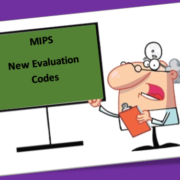Get Invested in New Evaluation Codes
By now, you’ve probably heard the news. January 1, 2017 marks the end of physical therapy evaluation codes 97001 and 97002, and the beginning of brand new evaluation codes based on patient complexity. The two old codes, established in 1998, are being replaced by four new codes: 97161 for low complexity evaluation, 97162 for moderate complexity evaluation, 97163 for high complexity evaluation, and 97164 for re-evaluation. For the first time, physical therapists will have a coding system that reflects on the variation in the treatment provided for a patient based on how complex the patient’s needs are. There will be new Occupational Therapy evaluation codes as well following the same design, however the codes themselves and the relative values differ.
Why should you be happy about the changing evaluation codes? Glance back in time with me for a moment. Physical therapy had its professional beginnings post World War I, when the US Army began a 3-month crash course to become a “Reconstruction Aide” in order to help treat wounded soldiers. Then came certificate programs, and in 1928 came the first establishment of basic standards for a school of physical therapy. A baccalaureate degree followed from 1950-1980, and as recently as 1999 formal education for a PT was elevated to a post-baccalaureate degree; a Master’s degree. As of January 2015, any student who attended a CAPTE certified institution and is sitting for their PT licensure examination will attain a Doctorate of Physical Therapy (DPT) when they pass. Why the short history lesson? Physical therapists began as aides in the health profession, and have progressed to become the experts on all things musculoskeletal. This level of professionalism will be reflected in a coding system that designates the level of difficulty involved in the clinical decision-making on each patient. The new evaluation codes focus on the complexity of the patient instead of the time spent with a patient, and allow you to stratify low to high cost patients. This is a system more similar to the E&M codes used by physicians. If that doesn’t sway you, maybe this next part will. These new CPT codes could be a big step towards a CMS payment reform. As of now, all codes will have the same associated reimbursement. CMS intends, however, to collect data for one year in order to: 1. Examine the distribution of low, moderate, high complexity patients and 2. Determine how accurately therapists document their clinical reasoning for their decision. Translation: Careful documentation and correct classification of patients by therapists gives CMS the tools to build a new fee schedule.
Consider the time you devote to mastering the intricacies of these new evaluation codes an investment in the future of your own practice and of the therapy profession. In wise the words of Warren Buffet (and who better to take investment advice from?) “Someone’s sitting in the shade today because someone else planted a tree a long time ago.” This framework is the planted seed. It provides infrastructure for payment reform down the road. Therapists nurture our hypothetical tree by nailing down the basics of these new evaluation codes; correctly identifying patients by complexity, and carefully documenting why the patient qualifies as low, moderate, or high complexity. (Keep this in mind as you consider Rehab EMR choices!) Stay tuned for more on the new codes themselves- the nitty gritty details on what constitutes an evaluation, qualifications for each code, and more.
Malcolm L. Bond, Ph.D. Cedaron’s Founder and Chief Scientist









